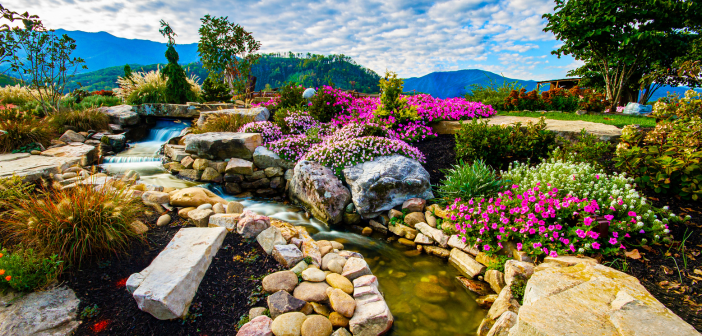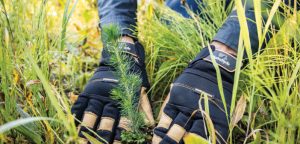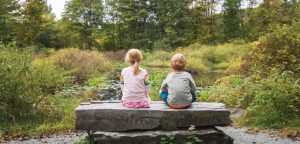Many adventure parks, zip lines, experiential programs, and camps exist in natural environments and aim to raise visitors’ awareness of the natural world. To that end, an increasing number are taking additional steps to incorporate natural habitats into their mission and marketing.
The term “natural habitat” describes a specific environment where an organism—plant or animal—lives and that provides everything the organism needs to survive. These habitats help create and maintain homes for insects and animals, which are increasingly displaced by human development. Reintroducing or preserving plant species that so many animals need for survival causes a positive feedback loop in which more and more insects and animals—and the benefits they bring—will return, be it butterflies, bees, birds, foxes, or other species. These natural areas are also often more tolerant of climate changes, such as drought and flooding, and even help control erosion.
In the aerial adventure setting, maintaining the health of your plant life and reducing erosion are important benefits to both the local wildlife and your operation. Here are some suggestions for maximizing your location.
Case Study: Anakeesta
At Anakeesta in Gatlinburg, Tenn., a 15,000-acre wildfire in December 2016 damaged much of the area surrounding the park and town. Anakeesta opted to rebuild its landscape better than it had been, through garden design and adding native trees and plants. Its mountaintop park, in particular, has more than 100 species of woody plants, which, among other criteria, earned Anakeesta status as a Level 2 Accredited Arboretum—a celebration of the park’s restoration, preservation, and education efforts.
Anakeesta’s Vista Gardens has become a thriving environment that has coaxed the return of a variety of native birds, bugs, and wildlife and created an inviting and quiet sanctuary in which visitors can immerse themselves. It provides a welcome contrast to the high-intensity activities elsewhere in the park, and especially to the gaudy entertainments downtown.
More broadly, the garden provides aesthetic appeal, supports local conservation efforts, increases the park’s biodiversity and educational opportunities, and improves public relations— park operators became leaders in the rebuilding efforts after the fire.
The “Why”
From both business and community perspectives, protecting and nurturing an operation’s natural habitat offer a host of benefits.
Environmental Conservation. By creating or preserving local ecosystems, parks become stewards of their natural surroundings. This supports the overall health of the environment by maintaining the sources of food and shelter that are essential for the survival of our non-human neighbors.
Species Conservation. Conservation efforts often focus on protecting species that are most at risk of extinction or endangerment.
Consider the monarch butterfly. While inherently beautiful to see and experience, their long annual migrations make monarchs especially noteworthy. Millions of them migrate from Canada to Mexico or California to overwinter. They will breed during their journey back north, and the survival of their young (caterpillars) depends exclusively on the milkweed plant. That dependence makes their reproductive efforts extremely fragile. If your operation is located within North America, simply planting local milkweed species on site supports the monarchs and gives your guests the chance to view the spectacle. There are countless examples of this.
Landscape Conservation. Reintroduction or preservation of native plant species can also help mitigate erosion, flooding, and wildfires and offer a relatively easy solution in high-risk environments. To ensure effectiveness, it’s important to focus on the risks specific to your area.
Native plants have evolved for the local environment and all of the ebbs and flows of its weather. If your site is subject to flooding, native plants are better able to absorb and retain excess water in their root systems, as their roots act as sponges and hold onto the additional water to slow down surface runoff.
If your operation is in a wildfire-prone area, many plants that are native to such areas have evolved to be fire-resistant and/or adapt to fire. They may have a thicker bark, a chemical compound to reduce flammability, or can quickly resprout from their root systems after a fire. These plants essentially reduce fuel loads, which make wildfires less intense and easier to control.
Biodiversity. Natural habitats foster biodiversity, i.e., the variety of plants and animals living in any particular area. Biodiverse habitats ensure ample food and shelter opportunities, are more resistant to disturbances (whether construction impacts or the impact of diseases), have more resilience to environmental changes (such as flooding or wildfire), and—bonus—offer natural beauty. These benefits support the balance that any type of habitat needs to continuously prosper.
By growing native plants and creating welcoming spaces for wildlife, outdoor operators can support a variety of species that can entertain guests and offer myriad education opportunities. For example, bats prefer small, dark hideaways in which to spend their daylight hours. An area can support bats by providing natural or manmade shelters, such as a hollowed tree well or a man-made bat box. In return, the bats help to control mosquito populations and pollinate plants.
Similar efforts can support various types of bees, spiders, birds, mammals, frogs, etc. Often, the simplest way to provide such habitats is to maintain or reintroduce native plants.
Educational Opportunities. Natural habitats provide an opportunity to develop educational programs about the environment, wildlife, and conservation. Operators can conduct guided tours, workshops, and create informational displays to engage visitors. Such acts of stewardship can help your guests feel more respectful of your operation.
A great example of this is at Alta Ski Area in Utah. The resort has planted more than 42,000 trees and 109,000 plants since 1991, and has restored 3,400 square feet of wetland. It formed the Alta Environmental Center in 2008 to ensure the sustainability of the ski area and its natural habitats.
The greatest outcome, though, comes from what it gives back to the community. From internships to tree-planting volunteer opportunities, Alta Environmental Center supports local efforts and educates visitors on the impact of increased development and use. Much of this is done in collaboration with other similarly focused local and national organizations, from the U.S. Forest Service to Tree Utah.
Aesthetic Appeal. Lush greenery, vibrant native flowers, and the presence of wildlife create a visually captivating atmosphere. The aesthetics alone can attract a broader audience. Adding benches and other viewpoints encourages guests to take it all in.
Public Relations. To reap the greatest benefits of your local habitat, tell your visitors the “what” and the “why.” Aligning with the values of eco-conscious consumers provides an opportunity to tell a story that goes beyond your infrastructure and makes the experience more personalized and inviting.
Where to Start
Plenty of resources and funding (more on that later) are available to support your efforts. Most importantly: Start with an understanding of what is native to your specific area. An online search can often reveal your native flora and fauna. Your search can be specific to your county and often to your town or city.
Books are another source. My favorite is “Nature’s Best Hope” by Doug Tallamy, which discusses the efforts we can implement in our own backyards.
Additional considerations are:
Strategic Placement. When creating natural habitats, choose locations that maximize impact. High-traffic areas are ideal for exposure and engagement. Placing habitats near or along adventure trails ensures visitors can interact with them easily.
To determine the suitability of a location, ask yourself:
1. What resources do I have for maintenance?
2. What are my goals—to begin an educational program, interact with the local community, tell a story?
3. Is this area easily accessible and/or already maintained? Natural landscapes often require little ongoing care, but do benefit from periodic management and monitoring.
4. What financial resources are available? You don’t have to complete your plan all at once. Natural habitats can be introduced or improved over time, and you can set long-term goals for the area(s) you select.
5. Do we have upcoming construction projects or renovations into which a natural habitat could be incorporated? Planting native species will often be beneficial, especially in recently disturbed soil.
Location Viability. It’s important to ensure that a potential site is truly viable. Is the location one you’re able to landscape? Is there access to water? What landforms and plants are already there? Consider how to incorporate these existing factors. A local resource, such as a landscaper or botanist, can help.
There is no space that is too urban or too rural to do this type of work. Some great choices for locations that could be improved or created include: around a gazebo or seating area; alongside pathways or parking lots; around buildings or offices; or beneath zip lines and aerial courses (especially if you introduce grassland plants).
Native Plants. Native species are not only well adapted to the local environment, they also help counteract the impact of the many invasive species that have been introduced through decorative gardening and landscaping. Often, local nurseries can provide seeds and seedlings to help you with your efforts.
In the United States, you can research native plants using the National Wildlife Federation (NWF) Native Plants Finder, available at nwf.org. Here, you can see which subspecies of milkweed is best to plant in your area to support monarch butterflies, for example, or search for a showy perennial flower.
Regular Maintenance. To keep your habitats vibrant and healthy, invest in regular maintenance, including weeding, pruning, and monitoring for invasive species. Educate your staff in the care of native plants. It doesn’t take much in terms of time, fertilizer (native plants require very little), or watering.
Water Features. Ponds or streams attract wildlife by giving them a source of clean drinking water. Birds, insects, and other animals that come for a drink often provide some essential services, such as pollination or pest control. Water features also serve as a quiet place for wildlife observation.
There are additional benefits of maintaining or installing a water feature, including being able to officially certify the location as a “Native Habitat” through the National Wildlife Federation.
Resources
It’s fairly easy for operators interested in pursuing native plant landscaping to find resources that can help.
Garden for Wildlife. The National Wildlife Federation’s “Garden for Wildlife” program provides guidance on transforming outdoor spaces into wildlife-friendly habitats. It also ships native plants to about half of the U.S. states, with plans to expand this program and even plant a native seedling for every purchase made.
Local Environmental Groups. Many local environmental organizations offer expertise, support, and volunteers to create and maintain natural habitats. They provide resources, advice, and sometimes even financial assistance.
Wildlife Conservation Organizations. Organizations such as the Audubon Society and the World Wildlife Fund can provide valuable information about local wildlife and conservation initiatives.
Support and Incentives
There are several financial benefits that operators can explore for improving their natural habitats:
1. Grants and Funding: Many environmental organizations offer grants or financial incentives for projects that promote conservation and sustainability. Among them:
a. Lorrie Otto Seeds for Education Grant.
b. USDA’s Conservation Reserve Enhancement Program.
c. Tax incentives and/or rebates for energy efficient landscaping.
d. State-based rebates. Many states will provide money (i.e., $3/square foot in Utah) if you transition your landscape into something that replicates the natural environment to conserve water.
2. Increased Visitors: As people seek more eco-friendly recreational experiences, operators with natural habitats can attract a broader audience. Do you offer nature tours? Walks with a naturalist? Incentives for homeschool groups? Market your space to a wider audience.
3. Partnerships: Collaborate with local businesses, environmental organizations, and educational institutions to create revenue-generating tours, presentations, or events centered on the natural habitat.

SE Group, a planning and design firm, integrated public spaces with native plants and local artwork into its mixed-use Market Street renovation in Burlington, Vt. Photo Credit: SE Group
Do It Yourself
Utilizing the personnel you have and the deep understanding of your landscape assets, here are steps to consider:
1. Assessment: Identify areas with potential for improvement or greatest visibility. Draw up a map of the different types of landscapes (grassland vs. forest vs. wetland, for example). This can be a simple drawing of buildings and garden plots or a more complex analysis of the amount of sun or water in that area.
2. Native Plant Selection: It’s best to pick a selection of flowering and woody plants, and to plant seedlings in the spring. Rely on information and advice from local experts or garden centers.
3. Habitat Design: Plan the layout, including paths, water features, and seating areas. Ensure it complements your park’s existing features. This doesn’t have to be large scale; you can start with a 10’x10’ plot for wildflowers and call it a “butterfly garden” and gradually make your landscape more and more native.
4. Staff Training: Train your staff to care for the habitat properly. Explain the “why” of your natural landscaping. Share social media and online resources for them to become educated and empowered.
5. Educational Programs: Develop educational programs and signage to engage and inform visitors. This is an opportunity to market and share your story. Start by labeling what you already have. The U.S. Forest Service has great examples of interpretive panels that are free to download.
Incorporating natural habitats at your aerial adventure or experiential business certainly benefits the environment, but it also enhances the visitor experience. It is a great start to sustainability and environmental conservation and will promote the positive message of stewardship for our planet.
Resources and financial incentives are available to support these efforts, and even operations with limited budgets can take steps to enhance their natural surroundings. Businesses that embrace natural habitats are poised to thrive in an era where environmental responsibility and unique experiences are valued by the public.
There are so many ways to enhance your local habitat. Choose those that suit you and your site and see how much of a difference you can make—for both your business and the greater environment alike.








